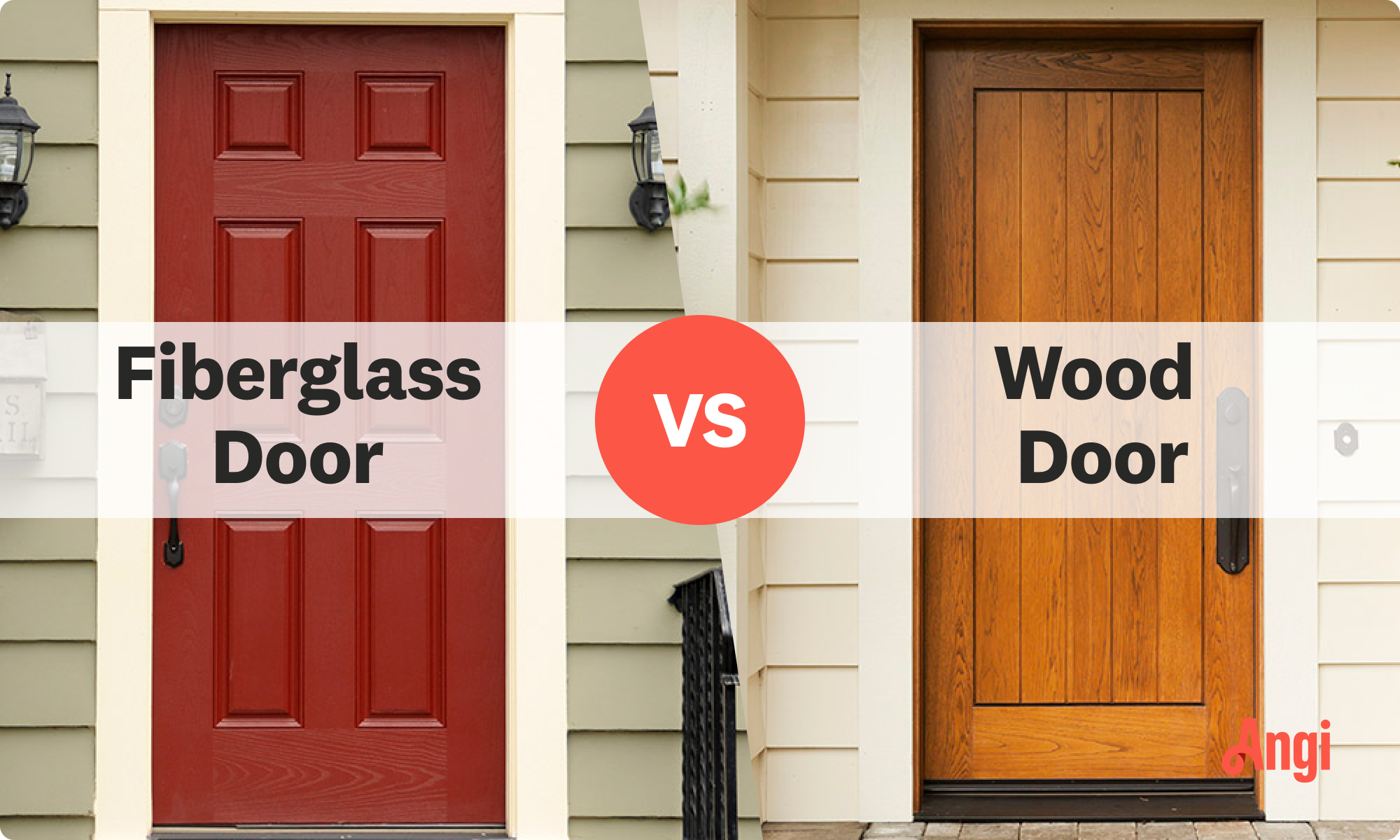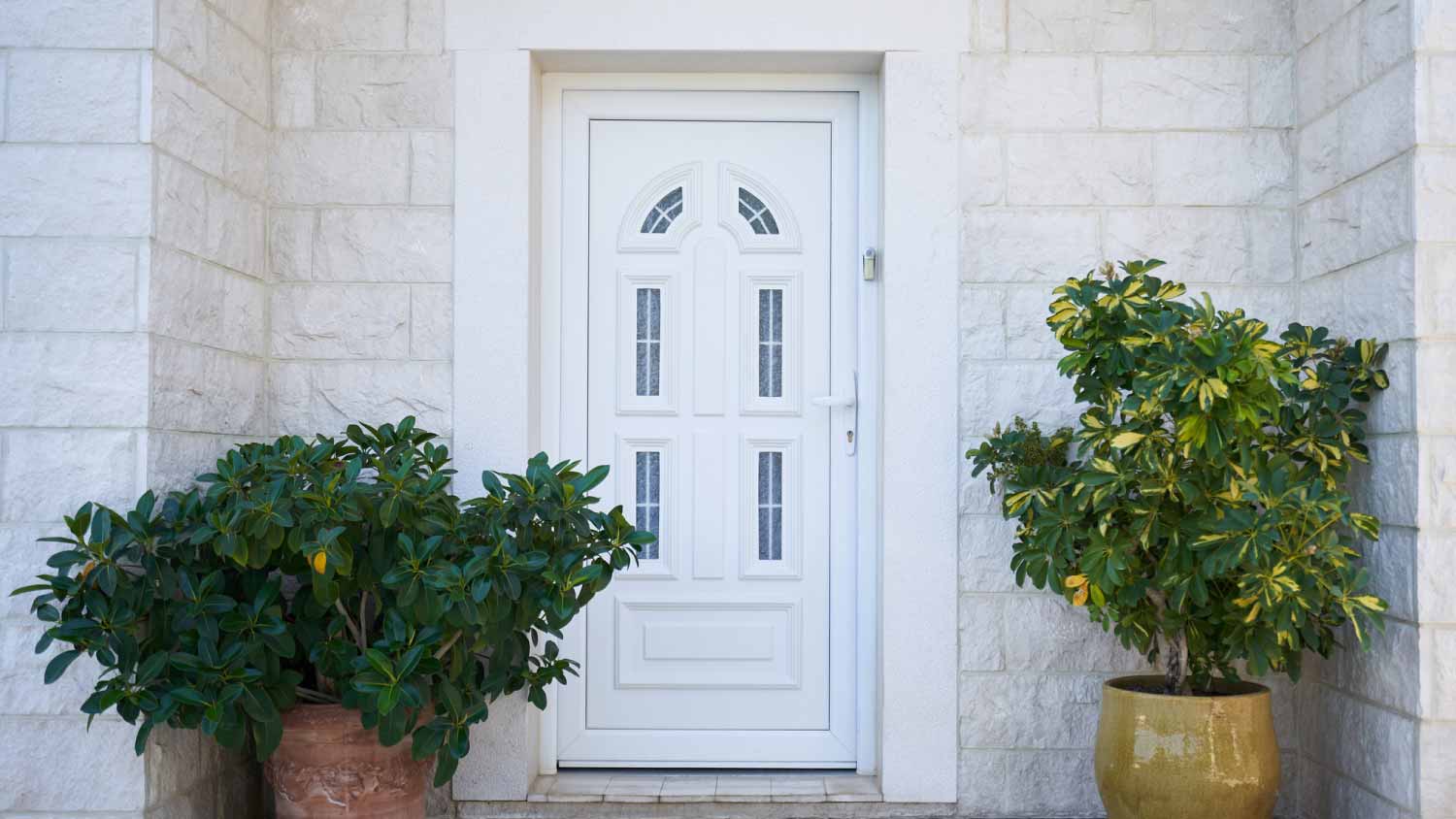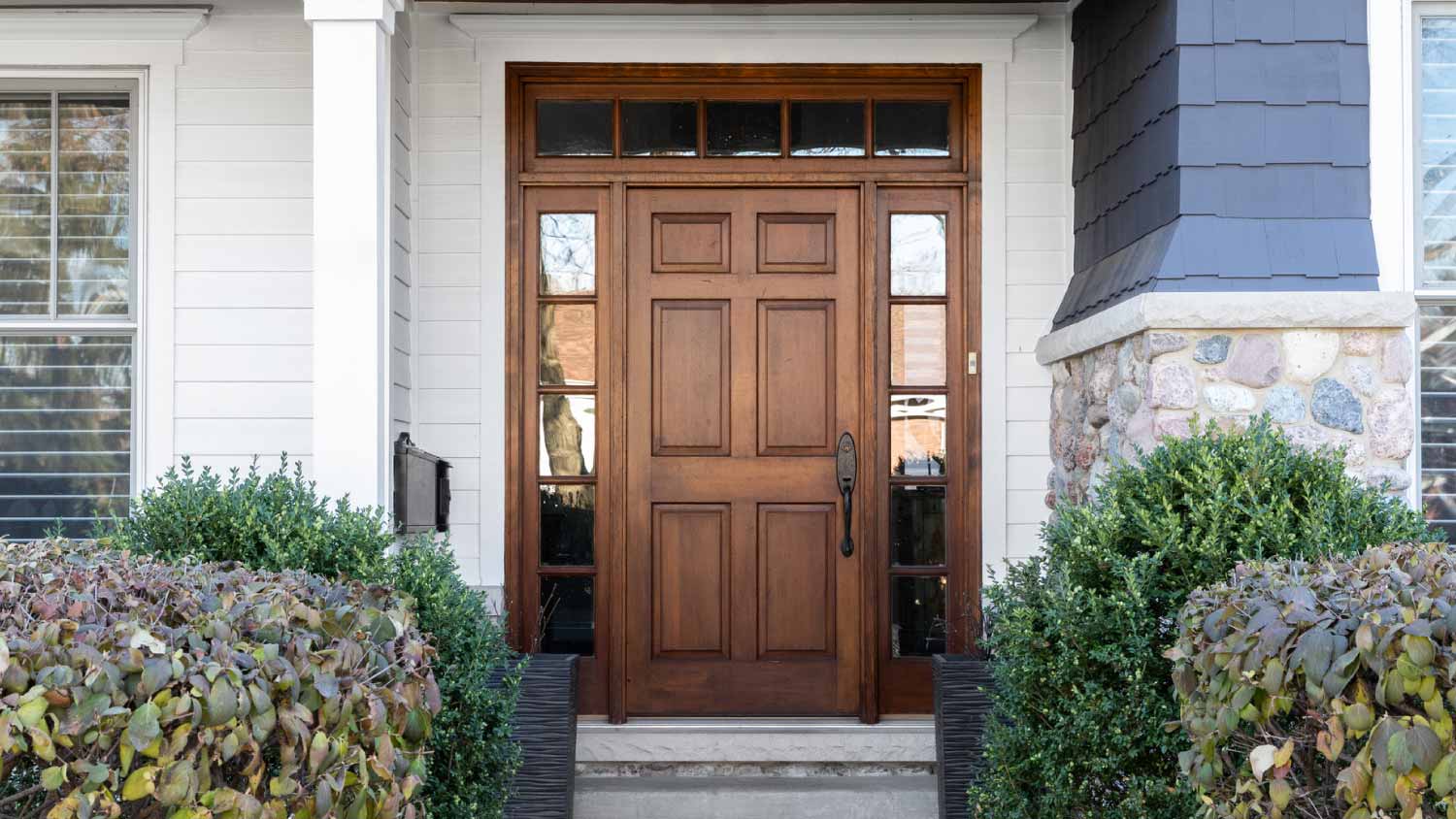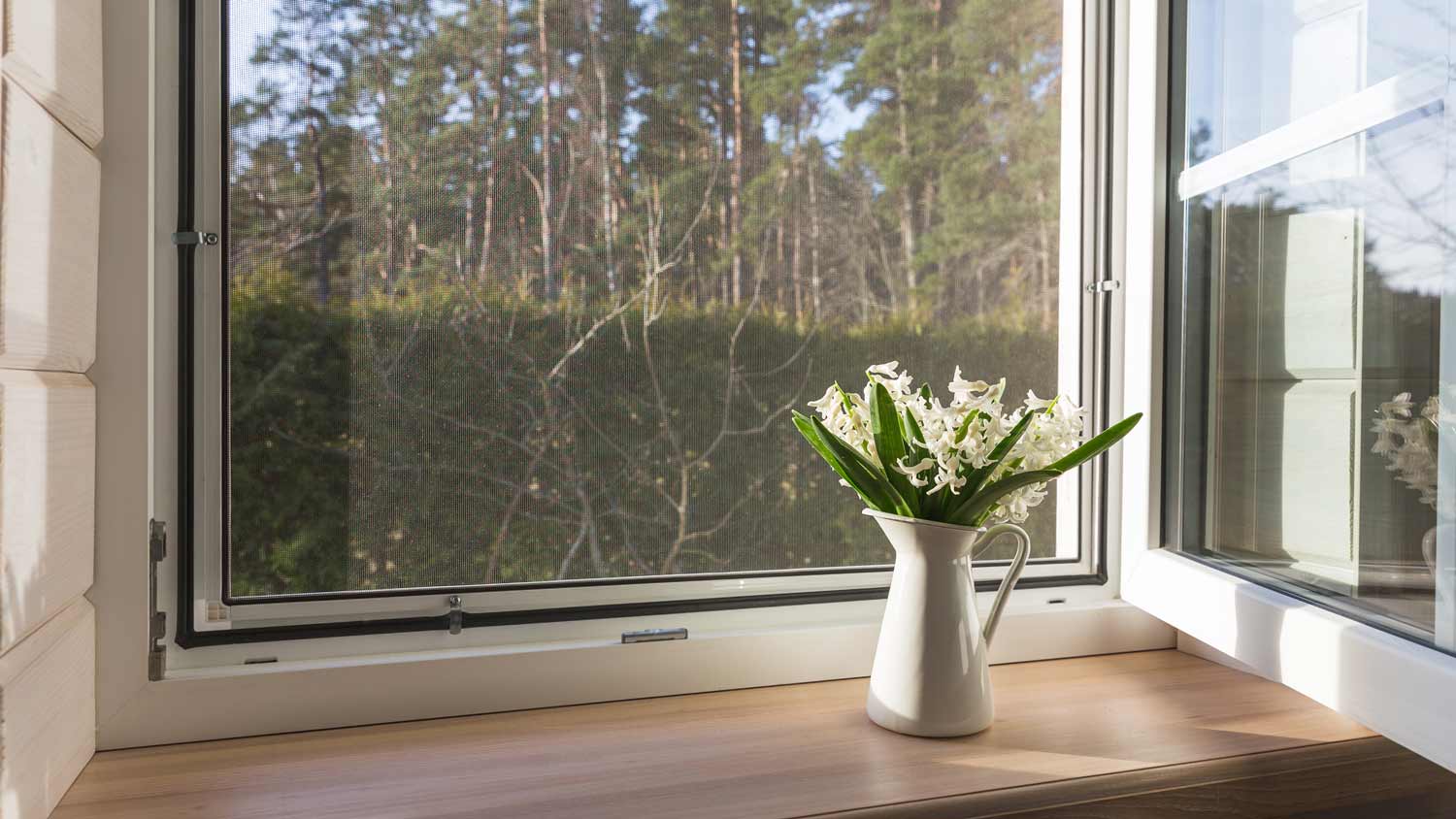Fiberglass vs. Wood Door: Which Is Best for Your Home?
Welcome guests to your home with the perfect front door


Fiberglass doors are durable, energy-efficient, and low-maintenance.
Wood doors offer timeless aesthetics and easy installation.
Both wood and fiberglass doors range in price from $250 to $5,000.
Wood doors are susceptible to weather and termite damage.
Your home’s front door can say a lot about the people who live inside. When choosing a new front door, fiberglass and wood doors are two of the most popular options, and each has its pros and cons. The available options for front doors can be overwhelming, but we’ve broken down the benefits and drawbacks of each type of door. If your front door shopping comes down to a fiberglass versus a wood door, use this guide to decide which is right for you and your home.
Fiberglass vs Wood Doors: Key Differences

While it might seem that fiberglass and wood front doors are largely similar, each offers something different in terms of durability, maintenance, ease of installation, energy efficiency, and more. Which one is right for your home depends on what you’re looking for in a door and what features are most important to you.
What Are Fiberglass Doors?

A more recent entry into front door choices, fiberglass doors are constructed of two layers of reinforced plastic material and an insulating foam core. Fiberglass doors are available in an array of styles—some even mimic wood grain—so you have plenty of options when looking for a fiberglass door that suits the look of your home.
| Pros | Cons |
|---|---|
| Energy-efficient | Expensive |
| Low-maintenance | Difficult to install |
| Highly durable | Not eco-friendly |
Best for:
Homes that are exposed to extreme weather
Homeowners who don’t want to perform regular maintenance
Homes with a more modern style
Pros of Fiberglass Doors
When it comes to energy efficiency, fiberglass is among the best in class. Their highly insulating foam core reduces heating or cooling loss to the outdoors, keeping energy bills down. Fiberglass doors also offer an advantage when it comes to maintenance. These doors require almost nothing in the way of upkeep, and are not prone to rot or warping. This helps with their durability, which is also impressive due to fiberglass’s resistance to damage like scratches, dings, and cracks.
Cons of Fiberglass Doors
All of that durability does come at a price. Most fiberglass front doors range from $250 to $2,000. Installation is also more complicated for fiberglass doors and may be a big project for DIYers. You may find that the cost of a new front door installation and hiring a door installer are worth it to be sure your door is installed properly. Unlike wood doors, fiberglass will not decompose once the door is removed and discarded.
What Are Wood Doors?

| Pros | Cons |
|---|---|
| Eco-friendly | Less energy-efficient |
| Timeless aesthetic | Susceptible to damage |
| Easy installation | Need to be repainted or stained |
Best for:
Homeowners who prefer a classic look
Homeowners who like to change their door color frequently
Homes in temperate climates
Pros of Wood Doors
Wood doors have been a popular option for a long time, and for good reason! Wood doors are an eco-friendly, sustainable choice for homeowners who prefer to use renewable resources in their homes. Wood doors also can’t be beat when it comes to aesthetics—the wide variety of styles and options mean there’s a door to suit every home, and wood doors are easily painted or re-stained when it’s time to freshen up the front porch. Wood doors are straightforward to install; handy homeowners should have little trouble putting in their new doors.
Cons of Wood Doors
While wood is an eco-friendly option because it’s a natural material, along with that comes some drawbacks. Exterior wood doors need regular maintenance and have to be repainted or re-stained regularly to stay looking like new. Wood is also susceptible to damage from the elements, like water damage or rot, and can be appealing to termites. While modern wood doors are more energy-efficient than older wood doors, they still may experience more heat loss than doors made of synthetic materials.
Fiberglass vs. Wood Doors
Appearance: Wood Doors
There’s no question that a wood door's timeless, classic aesthetic is appealing. While fiberglass doors can be made to look like wood, the depth and finish of real wood make it a very popular choice.
Durability: Fiberglass Doors
Fiberglass is designed to be tough, and it shows in how difficult it is to damage. A fiberglass door will resist dents and scratches, is not susceptible to moisture damage, and will not warp, shrink, or split.
Price: Wood Doors
Fiberglass and wood doors are available in a wide range of prices, with higher-end models of each costing up to $5,000. Wood composite doors are more budget-friendly than solid wood doors, but you might be sacrificing some aesthetics and energy efficiency.
High-quality doors can increase your home's resale value. If you plan to sell your home in the near future, a premium door material like solid wood or steel can make a positive impression on potential buyers.
Ease of Installation: Wood Doors
Wood doors are significantly easier to install than fiberglass doors, and are more easily altered or adjusted during installation. Fiberglass doors can’t be cut, planed, or easily readjusted, and it’s generally best to have a pro install them. DIYers can tackle wood door installation with standard tools and a little know-how.
Maintenance: Fiberglass Doors
When it comes to maintenance, fiberglass doors are the clear winner. Aside from surface cleaning with soap and water, there is almost nothing you need to do in order to maintain a fiberglass door, and they never need to be repainted (although you certainly can if you’d like to change up the look).
Ease of Repair: Wood Doors
While wood doors require more regular maintenance, they can be repaired much more easily than fiberglass. If fiberglass doors do get damaged, their construction prevents replacing parts of the door; in general, you’ll need to have a new door installed. Wood doors can be sanded, filled, and planed down, and it’s a straightforward process to repair or replace components or small areas of damage.
Energy Efficiency: Fiberglass Doors
Fiberglass’s insulating properties make it the more energy-efficient option. Homes that require a lot of heating and cooling will find that a fiberglass front door keeps energy loss to a minimum when compared with wood. In addition, wood can swell and contract, leaving gaps around the door that either need to be fixed with door sweeps or weatherstripping.
How Much Does It Cost to Install or Replace a Door?
The cost to install a door is determined by the material, the kind of door frame, the size and style of door you choose, whether you use a prehung or slab door, and more. On average, door installation costs $1,165, with homeowners spending between $500 and $1,880.
DIY vs. Hiring a Pro
Hiring a local door installation contractor costs $40 to $90 per hour for their labor, or around $30 to $40 per hour if you hire a handyperson. These costs vary depending on the contractor or handyperson’s experience with this kind of job.
Depending on the type of door you want and how handy you are, going DIY for a door installation shouldn’t pose too much of a problem. But a botched DIY here can cause problems in the long term, so it might be best to consult a professional so you can save on the repairs and get it done right the first time.





- Vinyl vs. Fiberglass Windows: Which Should You Choose?
- Open Up the Possibilities: 5 Must-Know Tips for Choosing the Perfect Front Door
- The Pros and Cons of Fiberglass Replacement Windows
- 5 Ways To Make Your Front Door Energy Efficient
- Do I Need a Storm Door? What to Consider
- Storm Door vs. Screen Door: How to Choose the Right One for Your Home
- Center-Hinged Patio Door vs. French Door: What’s the Difference?
- 8 Tips for Stylishly Updating Interior Doors
- 4 Types of Storm Doors and How to Choose the Best One
- How to Insulate a Door











